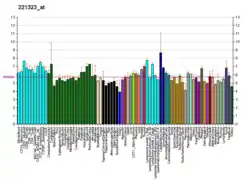| ULBP1 | |||||||||||||||||||||||||||||||||||||||||||||||||||
|---|---|---|---|---|---|---|---|---|---|---|---|---|---|---|---|---|---|---|---|---|---|---|---|---|---|---|---|---|---|---|---|---|---|---|---|---|---|---|---|---|---|---|---|---|---|---|---|---|---|---|---|
| Identifiers | |||||||||||||||||||||||||||||||||||||||||||||||||||
| Aliases | ULBP1, RAET1I, N2DL-1, NKG2DL1, UL16 binding protein 1 | ||||||||||||||||||||||||||||||||||||||||||||||||||
| External IDs | OMIM: 605697 MGI: 1925027 HomoloGene: 108274 GeneCards: ULBP1 | ||||||||||||||||||||||||||||||||||||||||||||||||||
| |||||||||||||||||||||||||||||||||||||||||||||||||||
| |||||||||||||||||||||||||||||||||||||||||||||||||||
| |||||||||||||||||||||||||||||||||||||||||||||||||||
| |||||||||||||||||||||||||||||||||||||||||||||||||||
| |||||||||||||||||||||||||||||||||||||||||||||||||||
| Wikidata | |||||||||||||||||||||||||||||||||||||||||||||||||||
| |||||||||||||||||||||||||||||||||||||||||||||||||||
UL16 binding protein 1 (ULBP1) is a cell surface glycoprotein encoded by ULBP1 gene located on the chromosome 6.[5][6] ULBP1 is related to MHC class I molecules, but its gene maps outside the MHC locus.[5][6] The domain structure of ULBP1 differs significantly from those of conventional MHC class I molecules. It does not contain the α3 domain and the transmembrane segment. ULBP1 is thus composed of only the α1α2 domain which is linked to the cell membrane by the GPI anchor.[5][6] It functions as a stress-induced ligand for NKG2D receptor.[5] ULBP1 is, for example, upregulated during HCMV infection.[7] Binding of HCMV-encoded UL16 glycoprotein to ULBP1 interferes with cell surface localization of ULBP1; this represents another mechanism by which HCMV-infected cells might escape the immune system.[7]
References
- 1 2 3 GRCh38: Ensembl release 89: ENSG00000111981 - Ensembl, May 2017
- 1 2 3 GRCm38: Ensembl release 89: ENSMUSG00000079685 - Ensembl, May 2017
- ↑ "Human PubMed Reference:". National Center for Biotechnology Information, U.S. National Library of Medicine.
- ↑ "Mouse PubMed Reference:". National Center for Biotechnology Information, U.S. National Library of Medicine.
- 1 2 3 4 Cosman D, Müllberg J, Sutherland CL, Chin W, Armitage R, Fanslow W, Kubin M, Chalupny NJ (Feb 2001). "ULBPs, novel MHC class I-related molecules, bind to CMV glycoprotein UL16 and stimulate NK cytotoxicity through the NKG2D receptor". Immunity. 14 (2): 123–33. doi:10.1016/S1074-7613(01)00095-4. PMID 11239445.
- 1 2 3 Radosavljevic M, Cuillerier B, Wilson MJ, Clément O, Wicker S, Gilfillan S, Beck S, Trowsdale J, Bahram S (Jan 2002). "A cluster of ten novel MHC class I related genes on human chromosome 6q24.2-q25.3". Genomics. 79 (1): 114–23. doi:10.1006/geno.2001.6673. PMID 11827464.
- 1 2 Rölle A, Mousavi-Jazi M, Eriksson M, Odeberg J, Söderberg-Nauclér C, Cosman D, Kärre K, Cerboni C (Jul 2003). "Effects of human cytomegalovirus infection on ligands for the activating NKG2D receptor of NK cells: up-regulation of UL16-binding protein (ULBP)1 and ULBP2 is counteracted by the viral UL16 protein". Journal of Immunology. 171 (2): 902–8. doi:10.4049/jimmunol.171.2.902. PMID 12847260.
Further reading
- Cerwenka A, Lanier LL (May 2003). "NKG2D ligands: unconventional MHC class I-like molecules exploited by viruses and cancer". Tissue Antigens. 61 (5): 335–43. doi:10.1034/j.1399-0039.2003.00070.x. PMID 12753652.
- Steinle A, Li P, Morris DL, Groh V, Lanier LL, Strong RK, Spies T (2001). "Interactions of human NKG2D with its ligands MICA, MICB, and homologs of the mouse RAE-1 protein family". Immunogenetics. 53 (4): 279–87. doi:10.1007/s002510100325. PMID 11491531. S2CID 33695596.
- Sutherland CL, Chalupny NJ, Schooley K, VandenBos T, Kubin M, Cosman D (Jan 2002). "UL16-binding proteins, novel MHC class I-related proteins, bind to NKG2D and activate multiple signaling pathways in primary NK cells". Journal of Immunology. 168 (2): 671–9. doi:10.4049/jimmunol.168.2.671. PMID 11777960.
- Dunn C, Chalupny NJ, Sutherland CL, Dosch S, Sivakumar PV, Johnson DC, Cosman D (Jun 2003). "Human cytomegalovirus glycoprotein UL16 causes intracellular sequestration of NKG2D ligands, protecting against natural killer cell cytotoxicity". The Journal of Experimental Medicine. 197 (11): 1427–39. doi:10.1084/jem.20022059. PMC 2193902. PMID 12782710.
- Rölle A, Mousavi-Jazi M, Eriksson M, Odeberg J, Söderberg-Nauclér C, Cosman D, Kärre K, Cerboni C (Jul 2003). "Effects of human cytomegalovirus infection on ligands for the activating NKG2D receptor of NK cells: up-regulation of UL16-binding protein (ULBP)1 and ULBP2 is counteracted by the viral UL16 protein". Journal of Immunology. 171 (2): 902–8. doi:10.4049/jimmunol.171.2.902. PMID 12847260.
- Eleme K, Taner SB, Onfelt B, Collinson LM, McCann FE, Chalupny NJ, Cosman D, Hopkins C, Magee AI, Davis DM (Apr 2004). "Cell surface organization of stress-inducible proteins ULBP and MICA that stimulate human NK cells and T cells via NKG2D". The Journal of Experimental Medicine. 199 (7): 1005–10. doi:10.1084/jem.20032194. PMC 2211882. PMID 15051759.
- Bacon L, Eagle RA, Meyer M, Easom N, Young NT, Trowsdale J (Jul 2004). "Two human ULBP/RAET1 molecules with transmembrane regions are ligands for NKG2D". Journal of Immunology. 173 (2): 1078–84. doi:10.4049/jimmunol.173.2.1078. PMID 15240696.
- López-Soto A, Quiñones-Lombraña A, López-Arbesú R, López-Larrea C, González S (Oct 2006). "Transcriptional regulation of ULBP1, a human ligand of the NKG2D receptor". The Journal of Biological Chemistry. 281 (41): 30419–30. doi:10.1074/jbc.M604868200. PMID 16901903.




